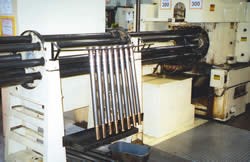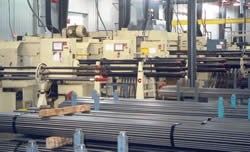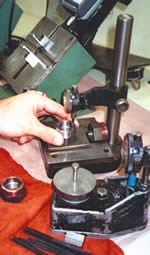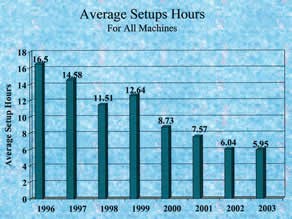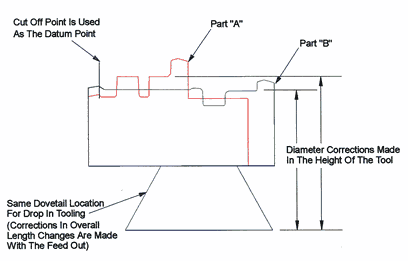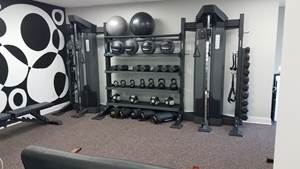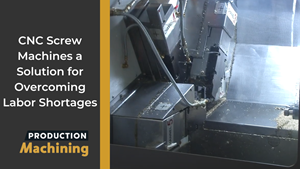Changing Your Approach To Change-Over
When you make your living cutting parts, maximizing the time spent making chips is a good thing. Tooling a machine up and down and up again is dead time spent away from making your living. This Ohio shop has figured out how to dramatically cut its dead time. They have created cultural change that most shops can and should implement.
After a pleasant drive from Cincinnati, Ohio to Delphos, Ohio, where we paralleled (in some areas) what's left of old Miami-Erie canal, Lori Beckman, our production manager, and I arrived at Vanamatic. We signed the guest book in the lobby and asked to see Jeff Wiltsie, president of manufacturing.
Vanamatic's building is sparkling new and built for the manufacturing needs of this 49-year-old family business. But while waiting for Jeff in the lobby, something seemed wrong to me. I mentioned to Lori that there should be the smell of oil. I said, "Either we're in the wrong place or these guys have a unique screw machine shop." It turns out the latter is correct.
Jeff arrived shortly and led us back to a large and very comfortable conference room. Steve Schroeder, Vanamatic's engineering manager, and Adam Wiltsie, a manufacturing engineer and part of the family's third generation, joined us at the conference table. After exchanging pleasantries and getting some coffee, we got down to business.
My mission for visiting Vanamatic was to find out the details of how this traditional multi-spindle screw machine house made itself competitive with foreign and domestic suppliers without a huge capital investment. The gist of the story is about adding capacity and production flexibility by reducing setup on the shop's mix of 20-plus Conomatics and New Britans.
But, there is much more here than just lowering change-over times. There is a process that has been put into motion that has reduced setup on the screw machines and spread throughout all aspects of the shop. It's that process that I want to learn more about.
Motivation
Earlier than most machine shops, Vanamatic sensed a need for change. Back in 1996, when much of the industry was enjoying good business levels and China's primary claim to fame was still the Great Wall, this company began looking at how to wring costs out of their process. "The prime driver came from our customers," Jeff recalls. "They were asking us to help them mesh our need for production volumes with their JIT inventory constraints, which led us to evaluate more closely how we ran the shop."
"Although they are older, Vanamatic's screw machines are still cutting productively and producing quality parts consistently. They are kept within close tolerances by an in-house rebuilding and maintenance program. Therefore, the primary cost-reduction focus became how to more efficiently tool and schedule on the multi-spindle automatics so they could be changed over faster in order to stay in the cut longer.
The benchmark when this effort began in 1996 was a total of 415 setups performed across the shop's screw machines for the year. The average time per setup was pegged at 16.5 hours. That represents a total of 6,848 hours of non-cutting time. Mining that dead time to extract additional production capacity seemed to represent a potentially rich cost saving vein for Vanamatic.
Getting Started
The lure of multi-spindle setup reduction is strong for any shop. Effectively, it allows a company to increase its productive capacity and reduce operational costs all while using existing capital equipment.
However, often the shear complexity of setup for a multi-spindle can make significant reductions difficult or expensive to accomplish. Vanamatic rejected that idea and came up with a plan to change over its machines quickly, efficiently and economically in order to take advantage of the non-cutting time.
According to Steve, the beginning of the setup reduction program began within the company. "The need was understood, so we turned to in-house for the innovation. We tapped engineering and the shop floor and started from there."
Like most metalworking operations, it's the application that calls the tune. Vanamatic chose to focus its first cost reduction efforts on a relatively simple family of parts they had made for some time. "We picked a family of parts that we thought we could have some good success with, the thinking was that success breeds success," Steve recalls.
The parts were chosen based on the same material and geometric features that were different only in size, and therefore, requiring a similar set of tooling. The operational steps for cutting were pretty much the same. The part family was planned beginning with the smallest and progressing to the largest.
"We looked at each position on the machine and asked, ‘How can we make this tool easier to setup?'" Steve explains. "Then, we worked our way around each spindle and hit it one at a time and reduced setup one tool at a time."
Another practice that was facilitated by the parts selection was the use of datum point tooling with common, dovetail holders on the cross slides. "We made our cross slides completely interchangeable, so the form tools could drop right in," Jeff says. "That gave us a the biggest time savings at the beginning. By using the part cutoff point as the datum point, we were able to quickly adjust for different lengths using feed-out and an in-house designed, quick-change stock stop. The form tools are designed to drop into the common holders so the holders' relative positions in the work zone are constant. That also allowed us to maintain a single cross slide stroke for different diameters in the family by varying the overall height of each form tool rather than adjusting the cross slide itself."
For endworking tools, the company took the tool setting function off the machine. The saddle of the machine was fitted with a quick-change system consisting of a base holder that is permanently mounted and designed to accept various toolholders. Like the cross slide holder, the location of these bases is known so only the cutting tool itself needs to be set. This is completed off line with a tool setting gage.
Another advantage of using preset tools and quick-change holders is during production. By keeping a duplicate set of preset tools ready in order to replace worn cutters, tool change is completed in a matter of seconds.
Talk about results. In the first year of the reduction program, setup for this initial part family went from an average of 10.15 hours to 3.74 hours. Moreover, the total setups performed only for this family went from 42 to 62 in the first year. For the Vanamatic employees, these results were certainly proof of concept.
Spend A Little, Save A Lot
The company expanded the fledging setup-reduction program across the rest of the shop quickly. In the mean time, the team assigned to setup reduction on the original family of parts continued the project. Basically, they functioned as a setup reduction proving ground for the rest of the shop.
With a tooling strategy in place, the team next tackled stock handling. "About this time, we came across Hardinge's line of quick-change collets," Jeff recalls. "For a next step in setup reduction, using them seemed to makes sense."
These collets work on a principle similar to quick-change tooling. A fixture or body is permanently mounted to the machine spindle. This body accepts a working range of collets that can be interchanged using a hydraulic release trigger. The pads are held in place by replaceable spacers so collets can be interchanged as a single unit. "We went from 2.5 hours for collet change-over to as low as 8 minutes using these quick change units," Steve says.
Changing collets often means changing pushers in the bar feeder to accommodate a new stock size. The company invested in duplicate sets of pushers for its multi-spindles. This allows the second set of pushers to be preset and waiting for the next job rather than shutting down the machine during the time required to set the pushers. Now, collet, pusher and bar changes are made in as few as 8 minutes on an eight-spindle machine.
"Compared to the cost savings from setup time reduction, the investment in quick-change tooling is nominal," Jeff says. "Moreover, with the exception of the collets, pushers and tool holders, most of the setup-reduction hardware has been created and built in-house."
Smart People Are Everywhere
A shop's culture can perpetuate old ways of looking at and doing the job, or it can be a seedbed where new ideas and better methods are cultivated. Vanamatic is creating an environment where good ideas are not evaluated based on their source.
"It's interesting to see how our employees responded to the challenge of setup reduction," Jeff says. "It became a contest to beat the previous best time for a given setup. Ideas started pouring into engineering. Most were very good and have truly impacted our setup-reduction program."
One such home-grown idea was a way to expedite setup of recess tools in the machine. "This one was pure innovation," Steve says. "To change the recess tool from one diameter to another, we use the old diameter as a datum, then use software we created to calculate how much adjustment is needed to get to the new diameter. We built a dial indicator that mounts in to the machine to set the adjustment once. The tool tip geometry is ground, and offsets are established in our tool room. Tool setting is done quickly in the machine, and this process eliminates the trial and error previously used to adjust these tools."
Gaging parts is another area where quick-change innovation found an outlet. Rather than set height gages and other bench measurement devices for each job, the shop came up with a way to keep the gage set at a fixed height and use interchangeable base plates machined to a specific thickness for each part. Dove-tails were installed on the gages for a quick change of the base plates.
Numerous other lean manufacturing techniques have been implemented at Vanamatic. The clarion call in the shop is setup preparation. From the toolroom to shipping, training is directed to encourage thinking and preparing for the next scheduled job as much as the current job being run. The results are impressive.
By The Numbers
When Vanamatic began its setup-reduction program in 1996, they selected a family of parts on an assigned a machine (#104) to try out the various innovations that were suggested by the shop. In the beginning, setup averaged 10.15 hours for that part family on that machine.
After implementing the setup reduction techniques and quick-change strategies, that machine currently averages 1.23 hours of setup. The record for #104 is 35 minutes, 20 seconds using two people for the setup. In 1996, 42 change-overs were done on #104 in a single year. Today, that machine is changed over 105 times a year.
For the entire shop, the setup average started at 16.5 hours for all 23 screw machines. Today, it averages 5.95 hours for all the machines. Setups for the entire shop were 415 in 1996. Now, the shop changes over 866 times a year.
Let's do the math: 415 setups multiplied by 16.5 hours equals 6,847.5 hours. Today, however, the number of setups has more than doubled. So 866 multiplied by 5.95 hours totals only 5,153 hours spent in setup.
As for customer response, which started the whole project, shop throughput from order release to shipping has dropped from 21 days to as few as 3 days. By continually coordinating the production schedule and order releases, the shop's goal is 12 turns per machine per year.
The company's savings in setup since the program began is more than $1 million. What's not obvious is the tremendous increase in production capacity that has been created using existing employees and capital equipment.
— Precision Machined Products Association
| Setting up a multi-spindle is complex. Setting up one in 35 minutes, 20 seconds is impressive. Here, with elapsed time, is the step-by-step setup of a 1 5/8 inch Conomatic model VNA using two people. | |
| Machine #104Time: 35:20 Setup performed by: Tom Williams & Scott Wiltsie NOTE: All times are finish times. |
|
| Clock into setup: Collets and pushers finished: |
0:00 5:40 |
| Left side positions 1-5: Scott •Strip all the tools: •Put the stock stop head on: •Put 1st, 2nd and 3rd drills in: •Set 2nd and 4th forms: •Put cutoff bushing in 3rd: •Set 4th position step reamer: •Set 5th position recess: |
8:15 9:12 11:30 12:30 14:05 17:50 18:39 |
| Right side positions 6-8: Tom •Change a position cutoff bushing: •Set 7th position recess holder: •Change spindle gears: •Set 5th and 6th recess bushings: •Get gages and place on bench: •Clean and put away gears, tooling: •Jog machine ahead and change pickoff: |
6:49 8:00 10:00 12:30 14:12 18:39 21:30 |
| Run machine and finish right side: Tom & Scott •Feed bar out: •Index machine to 7th: •Change 7th cutoff bushing: •Set 7th position reamer: |
23:00 24:25 25:20 26:20 |
| All tools in machine are set: •First piece off: •Put feed-out cam on: •Adjust 4th position step reamer: •First good piece off machine: |
26:20 27:45 29:20 33:20 35:00 |
| Clock out of setup: | 35:20 |
Related Content
Applying a Healthy Approach to Employee Investment
Service Center Metals’ on-site health center offers its employees and their families free same-day health care and, in return, the employer is gaining many benefits including a healthier workforce and attracting potential employees.
Read MoreEmerging Leader's Problem-Solving Skills Cool Down a Hot Project
This 2023 Emerging Leader developed a product in response to a call for help from Yamaha that was a huge hit in the snowmobile industry when it hit the market in 2010. In fact, it is now a common product that most snowmobile OEMs have implemented.
Read MoreVideo Tech Brief: CNC Screw Machines a Solution for Overcoming Labor Shortages
CNC screw machines can exceed job shop productivity and enable manufacturers to overcome perpetual employment gaps.
Read MoreStrengthening Manufacturing Workplaces Through Active Listening
A good strategy to weather the storms of manufacturing market upheavals and unpredictable factors is to commit to continuous, active employee listening.
Read MoreRead Next
Do You Have Single Points of Failure?
Plans need to be in place before a catastrophic event occurs.
Read More5 Aspects of PMTS I Appreciate
The three-day edition of the 2025 Precision Machining Technology Show kicks off at the start of April. I’ll be there, and here are some reasons why.
Read MoreA Tooling Workshop Worth a Visit
Marubeni Citizen-Cincom’s tooling and accessory workshop offers a chance to learn more about ancillary devices that can boost machining efficiency and capability.
Read More





